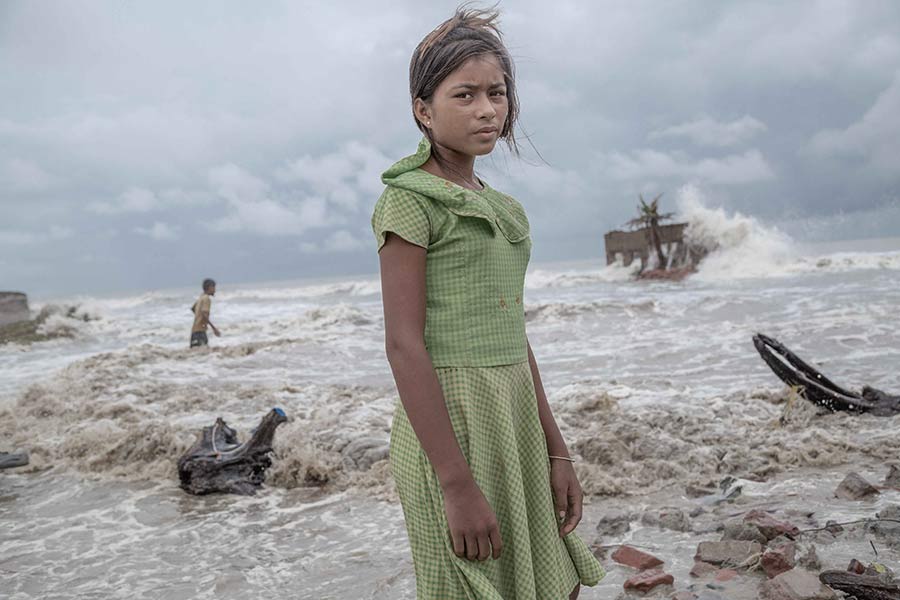This year’s winning image from the global Mangrove Action Project’s annual photography contest has captured the sad reality of the Sundarbans.
The photograph, which shows a young girl standing on Namkhana island in front of her tea stall ruined by encroaching seawater, has been captured by Bengal-based photographer Supratim Bhattacharjee.
The Mangrove Action Project provides training and education to help communities across the globe conserve and restore mangrove ecosystems to mitigate climate change effects.
Bhattacharjee’s haunting image showcases the existential threat posed by climate change to the world’s largest mangrove forest that straddles India and Bangladesh.
“The night before the photo was taken, I planned a visit to Lakkhipur village with my friend Goutam,” Bhattacharjee, who lives in South 24 Parganas near the Sundarbans, told The Telegraph Online.

"Through 'Sinking Sundarbans' I wanted to show how the people of Sundarbans are living under a constant threat from cyclones" said Supratim Bhattacharjee
“Fraserganj, where the picture was taken, lacks embankments, making it particularly vulnerable. I arrived early in the morning and witnessed the overwhelming force of the high tides. The residents of Lakkhipur, located in Frazerganj, were frantically trying to save their belongings from the encroaching sea water.
“Among them was 11-year-old Pallavi, whose house, which included a tea shop, had been completely submerged the previous night. Her composed demeanour and resilient expression amid the chaos compelled me to capture her photograph, showcasing her strength in the face of such devastation.”
How rising sea levels threaten Sundarbans’ existence
The Sundarbans face unprecedented challenges. Climate change, driven by global warming, is causing sea levels to rise at an alarming rate. Studies indicate that water levels in the Bay of Bengal are rising at about 4.4–6.3 mm per year, much faster than the global average.
This rise in sea levels has already led to significant land loss. Between 1973 and 2010, approximately 170 sq km of land, an area equivalent to the size of Calcutta, has been submerged.
Islands such as Mousuni and Ghoramara are already partially underwater, and the situation continues to deteriorate.
“Growing up, I frequently visited my maternal grandparents' home in Canning, near the Sundarbans,” Bhattacharjee reminisced. “I fondly remember the lush greenery and playing under the expansive, shady trees during scorching summer afternoons.
“However, nearly 28-30 years later, the landscape has dramatically changed,” he added.
“I have personally witnessed the drastic transformation of the landscape due to global warming and frequent cyclones. Rising sea levels, driven by global warming, have led to increasingly severe flooding from violent storm surges. Adding to the crisis is the reckless deforestation of mangrove forests. Many island residents are unaware of the long-term consequences of this destruction.”
How the people of Sundarbans are being hit by climate change
The people of the Sundarbans, heavily reliant on forest resources for their livelihood, are bearing the brunt of these changes. The cutting down of trees has further weakened the land, making it more susceptible to natural disasters. Storms, heavy rainfall, and floods are frequent, wreaking havoc on local communities and their means of subsistence such as reduced crop yields.
These challenges compound the daily struggles of the approximately 4.5 million people living in the Sundarbans delta in India alone.
“Sundarbans is always my second hometown and during cyclones, the experience I got is unforgettable,” Bhattacharjee said.
“I see people are moving everywhere for shelter, their home is being swept away by storm surges, their suffering to collect drinking water. I feel bad for the children of Sundarbans because they really do not deserve in between the environmental turbulence.”
Bhattacharjee’s award-winning photograph is from a project called Sinking Sundarbans that he started in 2009 and which is still ongoing.
“I wanted to show how the people of Sundarbans are living under a constant threat from cyclones,” said the photographer who is in his thirties. “How the villagers are habituated with seeing their houses getting drowned, belongings too without any reassurance of shelter. How losing one's shelter every other day has become a common phenomenon.
“My goal has been to bring the attention of the world leaders towards these climate refugees,” he added. “How cutting down mangroves had taken away the defences that the forest provided to the locals during storms.”


 (@supratimart)
(@supratimart)








